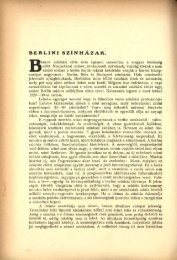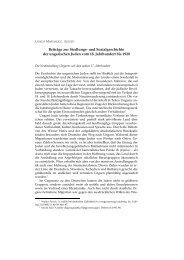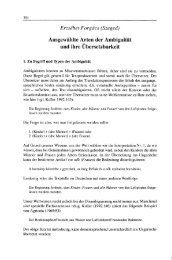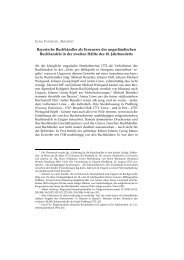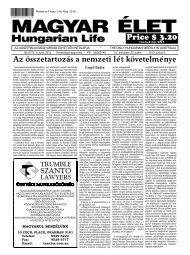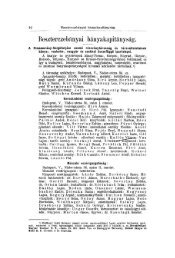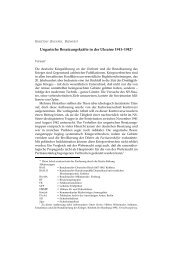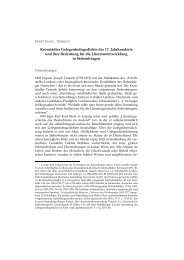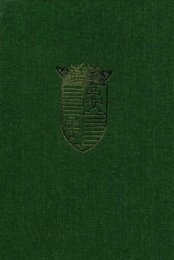hungarian studies - EPA - Országos Széchényi Könyvtár
hungarian studies - EPA - Országos Széchényi Könyvtár
hungarian studies - EPA - Országos Széchényi Könyvtár
You also want an ePaper? Increase the reach of your titles
YUMPU automatically turns print PDFs into web optimized ePapers that Google loves.
76<br />
ANIKÓ SOHÁR<br />
Blood Season. In the second edition the text and the appendices were extended,<br />
while the maps were omitted. All of these differences could, of course, also be<br />
explained by fictitious translation.<br />
I have compared the three versions of Blood Season with one another, word by<br />
word, sentence by sentence. In comparing the first chapter of the first two editions<br />
- and this is typical - I have found fifty-one slight differences (eight omissions,<br />
eight additions, thirty refashioned and longer sentences, and five variations in<br />
punctuation). There are seventy-six modifications between the second and the<br />
third editions (twenty-one omissions, thirty-three refashioned sentences, three<br />
additions, and nineteen variations in punctuation). The differences seem to move<br />
toward a more familiar, less literary and less archaic language. By deleting idiosyncrasies,<br />
the later editions appear to lessen the effect of the unmistakable style<br />
of Wayne Chapman. I assume that it may be linked with the fact that other, less<br />
talented authors started to contribute to M.A.G.U.S. series, and this required a<br />
more generic style.<br />
It seems likely that these changes reflect the genre's move from a new or 'peripheral'<br />
position to a more integrated or 'central' status, and that this move in<br />
turn reflects something of the overall process of cultural importation. In order to<br />
pursue this hypothesis I will briefly run through the main differences between the<br />
first, the second and the third editions of Blood Season, where the lack of external<br />
variables means that the changes are most clearly manifested.<br />
1. The layout is completely different, particularly with regard to the font used<br />
and the page formatting. The use of italics is rarely the same. The 'Author's Note'<br />
has a different place in the second edition, moving from the very beginning of the<br />
text to the end of the book. It has been deleted from the third edition. In the second<br />
and third editions there is a serious grammatical mistake in Shakespeare's sonnet,<br />
valld-valdd (sic!), imperative of 'vail' [admit/confess], and a reference is provided<br />
to the tenth sonnet, as translated by Lőrinc Szabó.<br />
2. The textual structure has been modified. For instance, the preface of the<br />
appendices has an added paragraph on cosmogony and philosophy in the second<br />
edition but its last part on the rules of transcription has been omitted from the third<br />
edition. It reads, "A különféle nyelvek neveit és szavait egységesen a dorani átírás<br />
szabályai szerint jegyeztem le, mert ez logikailag jóval közelebb áll az angolhoz..."<br />
[I have recorded the names and words of the different languages consistently according<br />
to the rules of transcription in Doran because this comes logically much<br />
closer to English ...] (my emphasis). The titles of the different parts of the novel<br />
have sometimes been altered, and poems have been added without references to<br />
all of the parts as mottoes. These include: 'Taba el-Ibara', instead of'Dél' [South];<br />
'Úton' [On the road] instead of 'Taba el-Ibara'; the third, fourth and fifth are<br />
unchanged, then: 'Az elátkozott vidék' [The accursed region]; 'Tetemre hívlak...'<br />
[approx. 'I call you to the ordeal of the bier'], which is in fact a very well-known



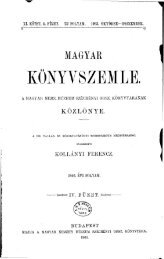
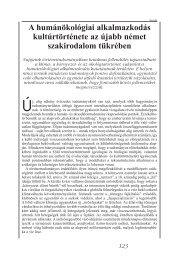
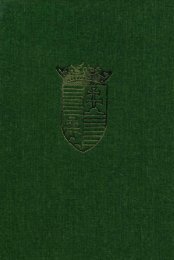
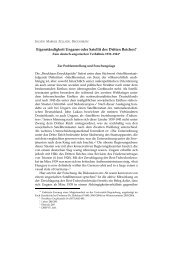
![Letöltés egy fájlban [36.8 MB - PDF] - EPA](https://img.yumpu.com/23369116/1/172x260/letoltes-egy-fajlban-368-mb-pdf-epa.jpg?quality=85)
